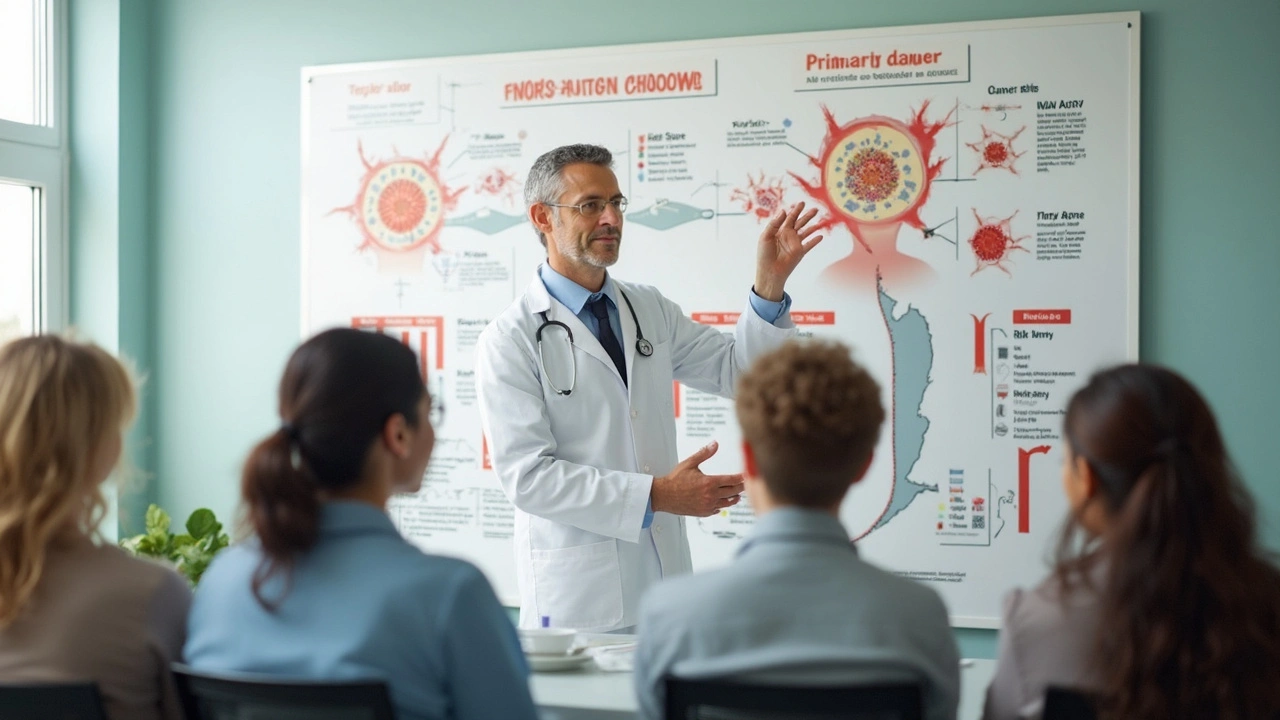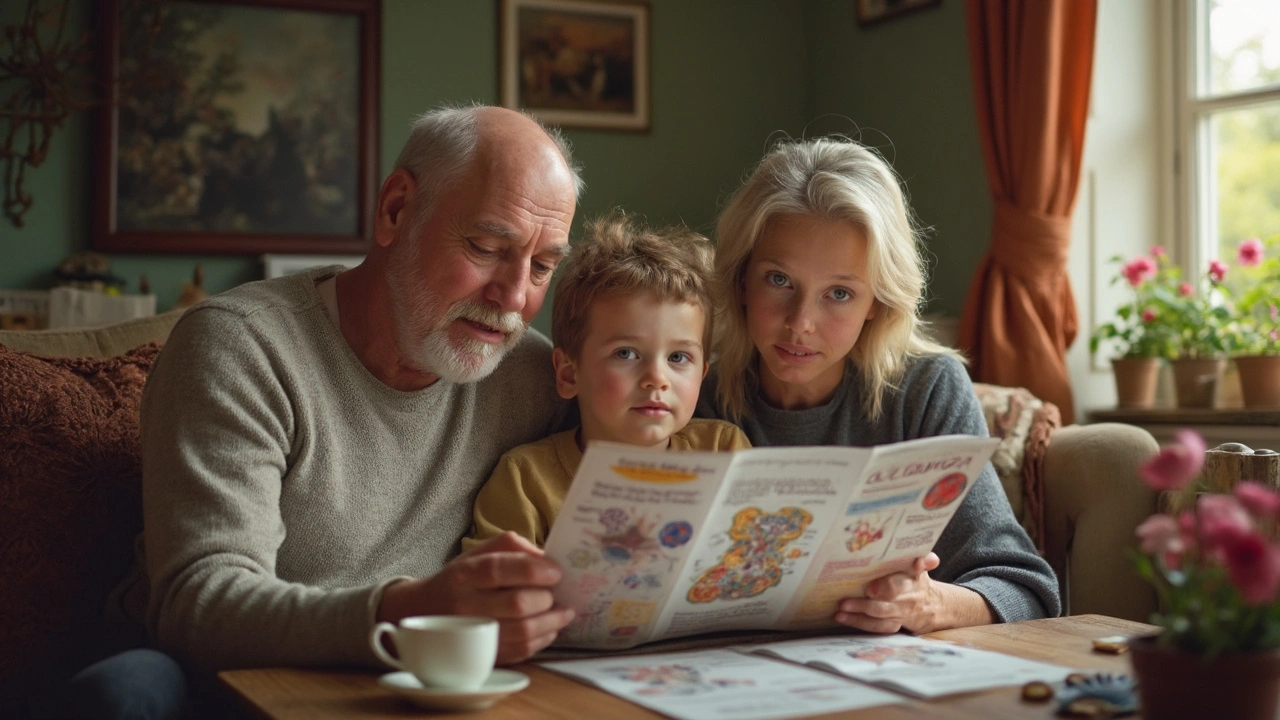If you ask someone what scares them most about cancer, many will say it’s not just the first diagnosis—it’s what happens next. The real punch in the gut is when another cancer pops up later, possibly in a totally different spot. This isn’t just a freak event; it’s a result of tumor growth behaving in ways most folks never see coming. Oncologists have seen it happen: a patient beats breast cancer, breathes easy for a few years, then faces lung or bone cancer, often because the first cancer's cells weren't quite done wreaking havoc. Tumor growth isn’t just about the swelling lump you can see or feel. It’s about how cancer cells sneak through the body, root themselves elsewhere, and sometimes cause new cancers altogether. The real kicker? Sometimes the treatment itself, while saving lives, nudges along these secondary cancers. Let’s peel back the curtain and see exactly how this happens, who’s at risk, and how to dodge the worst of it.
How Tumors Grow: The Wild World of Cell Mutation
Let’s set something straight: tumors are not just clumps of unhealthy cells minding their own business. They’re constantly evolving communities, competing with each other, and sometimes even learning to outsmart treatments meant to destroy them. If you think of a tumor as a city, it’s a city full of rebels—cells that love to break the rules of normal cell growth. They hijack the body’s natural systems, dodge the immune system, and if they find treatments blocking their path, they mutate to find new ways forward. These mutations aren’t just accidents; they’re built-in features of cancer’s biology. Every time a tumor cell divides (which can be more than a million times in an average tumor), there’s a chance a mistake will slip into its DNA. Some mistakes are harmless, but sometimes, these mutations unlock new skills—like resisting chemotherapy or moving to new parts of the body.
What most people don’t realize is that not every part of a tumor is the same. As the tumor grows, different sections of it might develop unique mutations. In one study published by Nature in 2023, researchers analyzed more than five thousand tumor biopsies and found that over 65% showed major differences in DNA from one end of the tumor to the other. This means while one patch of the tumor might shrink with treatment, another area could be gearing up to spread, unnoticed. Did you know that the fastest-growing tumors, like Burkitt lymphoma, can double in size in just 24-48 hours? That’s why doctors often act fast when they spot aggressive cancers.
This makes managing tumor growth tricky. If a single cancer cell with the right mutation manages to slip away, it hitchhikes through the blood or lymphatic system to new destinations—maybe the lungs, liver, or brain. That’s when metastatic cancer kicks off, which is the shadow every cancer patient dreads. And if that's not enough, some of these runaway cells can gather more genetic changes at their new destination, raising the risk of forming an entirely new type of tumor: a secondary cancer.
Let’s not forget the environment inside the tumor. Over time, tumors can create pockets where oxygen is low, which makes the local cells even more likely to mutate. According to a 2024 report from the American Association for Cancer Research, hypoxic (low-oxygen) zones inside tumors are hotspots for dangerous DNA changes. So, the more the tumor grows and outpaces its blood supply, the riskier the game becomes. Imagine tiny colonies of cancer cells, each rolling the dice every day, hoping for DNA changes that will help them survive, spread, or outmaneuver whatever drugs doctors throw at them.
Bottom line? The bigger and older the tumor, the higher the odds of it sending out seeds—cells that might set up shop elsewhere in the body. This is why early detection and shrinking tumors quickly can cut the risk of secondary cancers popping up down the line. Nobody wants to fight a battle on two fronts.
Secondary Cancers: What Are They and Why Do They Happen?
So, what exactly do doctors mean by "secondary cancer"? This term gets thrown around a lot, and it’s easy to mix up with metastasis. Metastasis is when original cancer cells break off, travel, and grow somewhere new. A secondary cancer, though, is a brand new cancer that starts in someone who's already had cancer before. It's not just a copy and paste of the first one but a whole different beast. Take the example of someone treated for Hodgkin lymphoma as a teen—years later, studies show they’re at a higher risk of developing thyroid or breast cancer. This is a genuine new tumor, not leftovers from the old one.
What causes this double trouble? First, let's talk about the cancer itself. Some genetic mutations that sparked the first tumor are still lurking in healthy tissues, quietly ticking away and waiting to trigger new trouble down the road. People with BRCA mutations, for example, not only face a higher risk of breast and ovarian cancer but also stomach, pancreatic, and prostate cancers. If those genes aren’t fixed, they leave the door open for fresh tumors.
Treatments can also be a factor. Certain chemotherapy drugs and radiation, as amazing as they are at saving lives, can damage DNA in normal cells, which can later mutate and turn cancerous. It’s the ultimate double-edged sword. The most famous example is survivors of childhood leukemia who develop acute myeloid leukemia decades after their first victory. This is why oncologists often weigh the risk of long-term side effects when picking treatments, especially for younger patients who’ve got decades ahead of them.
The risk isn’t the same for everyone, though. Age is a biggie—cancer survivors diagnosed before age 30 face higher odds of developing secondary cancers, mainly because their bodies haven’t had as much time to rack up natural mutations, so treatments hit their developing systems harder. Another key point: lifestyle matters. Smoking after surviving cancer, for instance, hikes the risk of lung, bladder, and throat cancers, regardless of the original diagnosis. Obesity and heavy drinking pile on more risk, letting rogue tumor cells find new places to take root.
Take a look at the numbers—this table lays out some real data on secondary cancer risk for survivors:
| Primary Cancer Survivor Type | Chance of Secondary Cancer (10 Years) |
|---|---|
| Breast Cancer | Latest studies: 13-15% |
| Testicular Cancer | 9% |
| Childhood Leukemia | Up to 20% |
| Hodgkin Lymphoma | 18% |
| Prostate Cancer | 6-8% |
So that fear many survivors feel about second cancers? It’s not just in their heads. It’s a documented, quantifiable risk—and one that doctors watch closely for years after the first treatment wraps up.

What Triggers Tumor Spread and Secondary Cancer Development?
If you’re wondering what makes cancer cells pack up and move, it’s a wild mix of bad luck and the body’s own biology. Not every tumor cell is cut out for the journey—only a few will survive the hostile world outside their home. Many drop out of circulation on the way, but those that make it can adapt to almost any tissue they land in. The biggest triggers for this migration? Persistent inflammation, certain genetic mutations, and sometimes the very treatments meant to kill these cells.
Let’s take a deeper look at inflammation. Chronic inflammation, from things like smoking, heavy drinking, or untreated infections, showers tissues with chemicals that make it easier for tumor cells to stick, survive, and thrive in new locations. The link isn’t just theoretical; a 2022 study tracked over 12,000 post-cancer patients and found those with ongoing inflammatory conditions (like Crohn’s or hepatitis) had almost double the rate of secondary tumors. Sometimes, inflammation lingers after radiation therapy, quietly prepping the soil for new cancer growth.
Certain tumor types are more likely to spread and cause secondary cancers. For example, melanoma is like the ninja of cancers—it can pop up just about anywhere the original cells land. Breast and prostate cancers also love to travel, especially to bone. Colorectal cancers, if left unchecked, can sneak into the liver or lungs. And here’s something not many people realize: smaller, slow-growing tumors can fly under the radar for years before they finally spread, which is why "watch and wait" only works in specific, carefully monitored cases.
Let’s talk treatments again. Chemotherapy and radiation work by damaging DNA in fast-dividing cells. The problem is, normal cells—especially in the bone marrow, mouth, and digestive tract—also divide quickly, so they take some collateral damage. Sometimes the DNA damage is so serious that, years later, a new cancer forms from those previously healthy cells. It’s tragic irony, and it’s why modern cancer care tries to balance aggressive treatment with minimizing risk. Newer targeted therapies and immunotherapies are great at zeroing in on tumors while sparing healthy cells, but secondary cancers can still sneak through, especially if the original tumor had a high mutation rate to begin with.
Doctors keep close tabs through follow-up screenings and blood tests. Imaging has gotten better—PET scans and liquid biopsies can spot sneaky cells much earlier now. Patient history matters a lot, too: someone who had both Hodgkin lymphoma and a ton of chest radiation in the early 2000s would be tracked closely for breast or lung cancer, sometimes for 20 years after the original treatment.
Want a little hope? Some lifestyle tweaks really can lower the odds. Keeping a healthy weight, ditching tobacco, staying on top of health screenings, and controlling chronic inflammation (through diet, regular movement, or meds) does make a difference. While you can’t change your underlying genes, you can make the environment inside your body a little less friendly for future cancer cells. That’s not just feel-good advice—it’s echoed in recent studies that show cancer survivors who stay active, eat loads of produce, and skip cigarettes cut their risk of secondary cancers by more than 20% compared to those who don’t. No magic bullet, but it’s proof you have some power in this fight.
Tips for Reducing the Risk of Secondary Cancers
So you—or someone you care about—has beaten cancer. Now what? The battle isn’t over, but the good news is, there’s a real menu of options for reducing future risk. Some are simple habits; others involve teaming up with your healthcare crew for regular checkups. Here’s a run-down of what works, back by solid science—not wishful thinking:
- Stay vigilant with screenings: Your doctor will recommend specific checks, like mammograms, colonoscopies, or thyroid ultrasounds, depending on what cancer you’ve had. Never skip these. Early detection is everything when new cells start acting up.
- Power up your plate: Focus on leafy greens, berries, nuts, and healthy fats. Studies—like the 2023 EPIC cohort—found survivors who ate seven or more servings of fruits/veggies a day had a 23% lower risk of secondary cancer.
- Keep moving: You don’t need marathons. Walking, yoga, swimming—just get 150 minutes of activity each week. Exercise helps fight inflammation and boosts your immune system.
- Drop the cigarettes: You already know why. Survivors who quit smoking slash their future risk by nearly 40%, especially with lung, bladder, and throat cancers, says the National Cancer Institute.
- Watch your weight: Excess fat cells create chronic inflammation. Keeping your BMI in check cuts risk across the board.
- Limit the booze: Alcohol—especially heavy drinking—makes the liver work overtime and spikes your risk, especially after breast or digestive tract cancers.
- Stick to the plan: Take your meds, hormone blockers, or immunotherapy as prescribed. Skipping doses can let sneaky cancer cells regroup.
- Check your family history: Some folks have stronger inherited cancer risks. If multiple family members have had tumors, genetic counseling is worth it. Fixing those risks early matters.
You can ask your oncology team about joining a cancer survivorship program. These services walk you through everything: treatment effects, late risks, new screening schedules, and healthy lifestyle options. It’s not just about beating the first cancer, but making sure you never have to go through round two.
And don’t minimize side effects. Fatigue, memory fuzz, or strange pains shouldn’t be shrugged off. Tell your doctor when something feels off. Many secondary cancers start with vague symptoms—don’t let them fly under the radar because you’re “supposed to be fine now.”
Here’s a quick checklist for life after your first cancer:
- Keep every follow-up appointment
- Maintain copies of your cancer treatment and pathology reports
- Know your specific risks based on your treatment history
- Adopt healthy routines for eating, moving, and sleeping
- Stay connected—mental health matters, support groups help
Finally, a little perspective—surviving cancer once shows you can fight hard. Knowledge is power. By understanding tumor growth and the risk of secondary cancer risk, you’re turning fear into action, and action into real results. It’s not about living in the shadow of cancer; it’s about arming yourself for whatever comes next.




